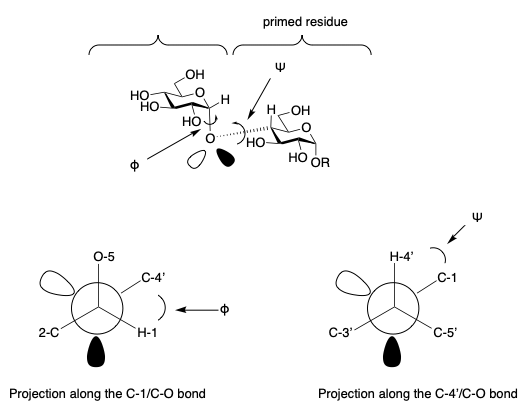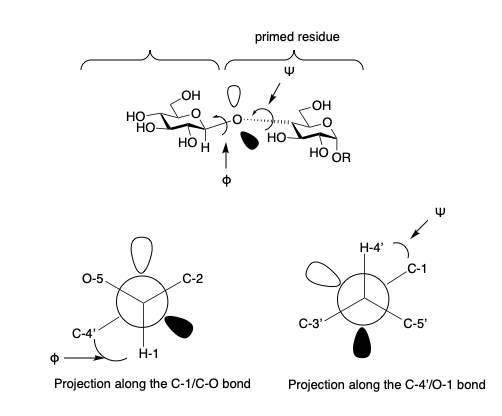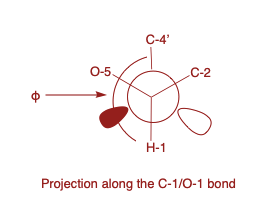Glycosidic bonds, the linkages between sugar molecules, are the building blocks of complex carbohydrates found everywhere from DNA to cellulose. But did you know that these seemingly simple connections hold a hidden layer of complexity within their rotation? Yep, we’re talking about glycosidic torsion angles – the invisible dance of twisting atoms that dictates the three-dimensional shape and function of countless biomolecules. Buckle up, because we’re about to delve into this fascinating world!
Content to Contemplate:
1. What are glycosidic torsion angles?
- Imagine two sugar rings linked by a glycosidic bond. Glycosidic torsion angles, denoted by φ (phi) and ψ (psi), describe the rotational angles between these rings around the bond. Think of them as the twist and turn of the sugar duo!
- φ– dihedral angle between H-1 and C-X’.
- ψ- dihedral angle between H-X’ and C-1.
- Constraints put on these angles by the exo-anomeric effect and steric considerations.
- For the α-glycoside, the preferred conformation has the aglycone projection into the plane.

- Orbital overlap with other lone pair of the glycosidic oxygen causes bad steric interaction. Newman projection.

- For the β-glycoside, again the preferred conformation has the aglycone projecting into the plane.

- Orbital overlap with the other lone on the glycosidic oxygen pair causes bad steric interactions.

- φ is typically 45-60 degree – heavily influenced by the anomeric effect. For smaller aglycone the angles is closer to 60 degree, for the larger aglycone closer to 45 degree.
- ψ is typically 0 (+,-) 20 degree. Most sensitive to the steric interaction.
2. Why are they important?
These angles aren’t just for show! They determine:
- Shape and stability: Different φ and ψ values lead to distinct molecule shapes, impacting everything from enzyme-substrate interactions to protein folding.
- Function: For example, α-amylase, a starch-digesting enzyme, relies on specific torsion angles for its sugar-grabbing abilities.
3. Exploring the angles:
- Each type of glycosidic linkage (α or β) has preferred φ and ψ ranges. We can measure these angles using X-ray crystallography, NMR spectroscopy, and computational methods.
- But be warned, it’s not always a static picture! Glycosidic bonds can exhibit flexibility, changing angles depending on their environment.
4. Real-world applications:
Understanding glycosidic torsion angles is crucial in various fields like:
- Drug discovery: Targeting carbohydrate-based mechanisms in diseases like cancer and diabetes.
- Biotechnology: Engineering enzymes with enhanced properties for industrial applications.
- Food science: Designing healthier food products by manipulating carbohydra
FAQs for the Inquisitive Mind:
1. How many glycosidic torsion angles are there?
- Most disaccharides have two (φ and ψ), but complex carbohydrates can have many more!
2. What factors influence glycosidic torsion angles?
- Steric clashes, hydrogen bonding, and interactions with neighboring molecules all play a role.
3. Can we manipulate glycosidic torsion angles?
- Yes! Chemical modifications, mutations, and even environmental factors can alter these angles.
4. Are there any resources for further exploration?
- Databases like the Cambridge Structural Database and software like PyMOL can visualize and analyze glycosidic torsion angles.
5. Is there a future for glycosidic torsions in research?
- Absolutely! With advancements in technology and our understanding of carbohydrate biology, the possibilities are endless!
Remember, glycosidic torsion angles may seem small, but their impact is vast. So, keep twisting and turning those molecules in your mind, and unlock the secrets of the sugary world!
P.S. Don’t be afraid to delve deeper into specific topics mentioned here. Research papers, review articles, and online tutorials are your friends! And if you have any questions, feel free to comment below – let’s keep the glycosidic conversation flowing!

Pingback: Fischer Glycosylation: A Journey into the Realm of Carbohydrate Chemistry -